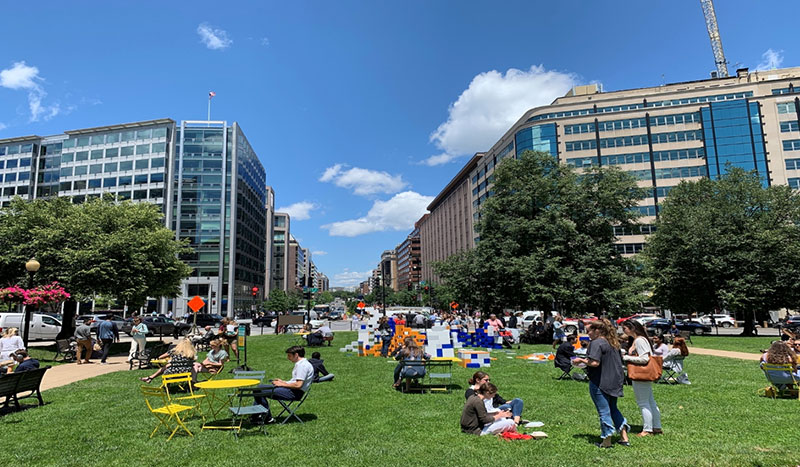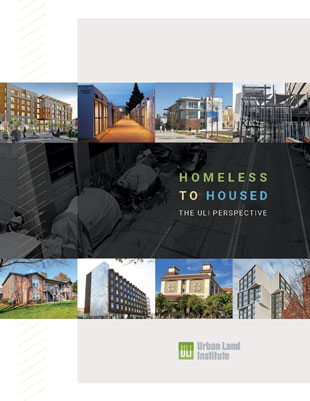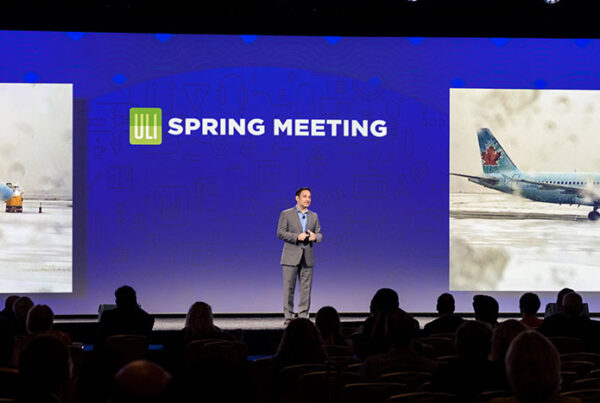
Farragut Park in northwest Washington, D.C.
Washington, D.C., can advance the recovery of the business, tourist, and neighborhood activity in its central business district (CBD) through multiple community-led initiatives, according to a new ULI report, based on the first ULI Virtual Advisory Services panel (vASP).
The report is based on recommendations from a panel of land use and resilience efforts convened last November through the Institute’s vASP offering. The vASP is a 2.5-day program tailored to meet a sponsor’s needs. For a virtual panel, ULI members are briefed by the sponsor, engage with stakeholders through in-depth interviews, deliberate on their recommendations, and make a final presentation of those recommendations. A written executive summary report is prepared as a final deliverable.
The panel recommended that the District:
- Diversify the downtown economy: Downtown D.C. needs to change in response to the competition of new, mixed-use districts by diversifying its economy, attracting technology and innovation enterprises, and shifting the existing office supply to broaden its offerings to attract post-pandemic firms and workers.
- Build equity, ownership, and asset value: D.C. has an opportunity to approach a new vision for a downtown that is for everyone. Now is the time for the city to focus on building equity, ownership, and asset value in this part of the city, where it has not existed before.
- Support and elevate small businesses: A robust plan for welcoming and sustaining small businesses is essential to grow diverse experiences as well as to generate a broader range of jobs for District residents and investors.
- Advance workforce training with a downtown focus: Employers seeking talent need to expand their training initiatives to partner with business entities, academic institutions, civic organizations, and philanthropic entities to coalesce around the immediate and future need for workforce training and development.
- Create an inclusive and vibrant identity for downtown: Now is the time to envision and invest in the distinctive and active public realm of downtown D.C., collaborating with the city to support safe streets, convenient transit choices, and public places for a sustaining and more diverse live/work CBD while showcasing its past, diversifying its present, and creating memorable experiences and enduring vibrancy.
“In response to the devastating economic and social impacts of COVID-19, the city of Washington needs to catalyze a more diverse, more resilient, and more inclusive CBD composed of multiple and distinctive neighborhoods which attract new economic assets that will vitalize the everyday life at the heart of the nation’s capital,” said Marilyn J. Taylor, chair of the advisory panel. “This vision can be achieved, starting now, through support to community-based, local small businesses and cultural programs that create a sense of place that is welcoming, inclusive, and safe for all.”
Taylor was joined on the panel by William A. Gilchrist, director of planning and building, city of Oakland, California; David Greensfelder, founder and managing principal, Greensfelder Real Estate Strategy, Albany, New York; Diane Gormely-Barnes, principal planner, HNTB Corporation, Chicago; James Lima, president, James Lima Planning + Development, New York; Julie O’Brochta, associate, Skidmore, Owings & Merrill LLP, Chicago; and Maggie Parker, managing partner, Innovan Neighborhoods LLC, Dallas.
“Washington, D.C., is strong and resilient, and this study shows that we can and will ensure the vibrancy of our central business district,” said John Falcicchio, deputy mayor for planning and economic development. “I am proud that the District, partnering with our central business district stakeholders, has already begun the innovative work of transforming the central business district with equity and inclusivity top of mind. We will continue to implement successful return-to-the-office strategies, reimagine our public spaces, and more because our central business district is the economic engine of the District and the region.”
A new Advisory Services product, the vASP was created as a response to continuing ULI’s mission of creating vibrant, sustainable communities during the COVID-19 pandemic. The vASP is a 2.5-day panel that convenes a multidisciplinary panel of experts from across the United States who possess a range of professional backgrounds and use their collective skills to meet the needs of an identified land use or policy challenge.
Now in its 72nd year, the ULI Advisory Services program assembles experts in the fields of real estate and land use planning to participate on panels worldwide, offering recommendations for complex planning and development projects, programs, and policies. Panels have developed more than 700 studies for land uses ranging from waterfront properties to inner-city retail.
According to Thomas Eitler, senior vice president of the Advisory Services program, the strength of the program lies in the Institute’s unique ability to draw on the substantial knowledge of its 45,000-plus members, including land developers, engineers, public officials, academics, lenders, architects, planners, and urban designers. “The independent views of the panelists bring a fresh perspective to the land use challenge,” Eitler said. “The Advisory Services program is all about offering creative, innovative approaches to community building.”




